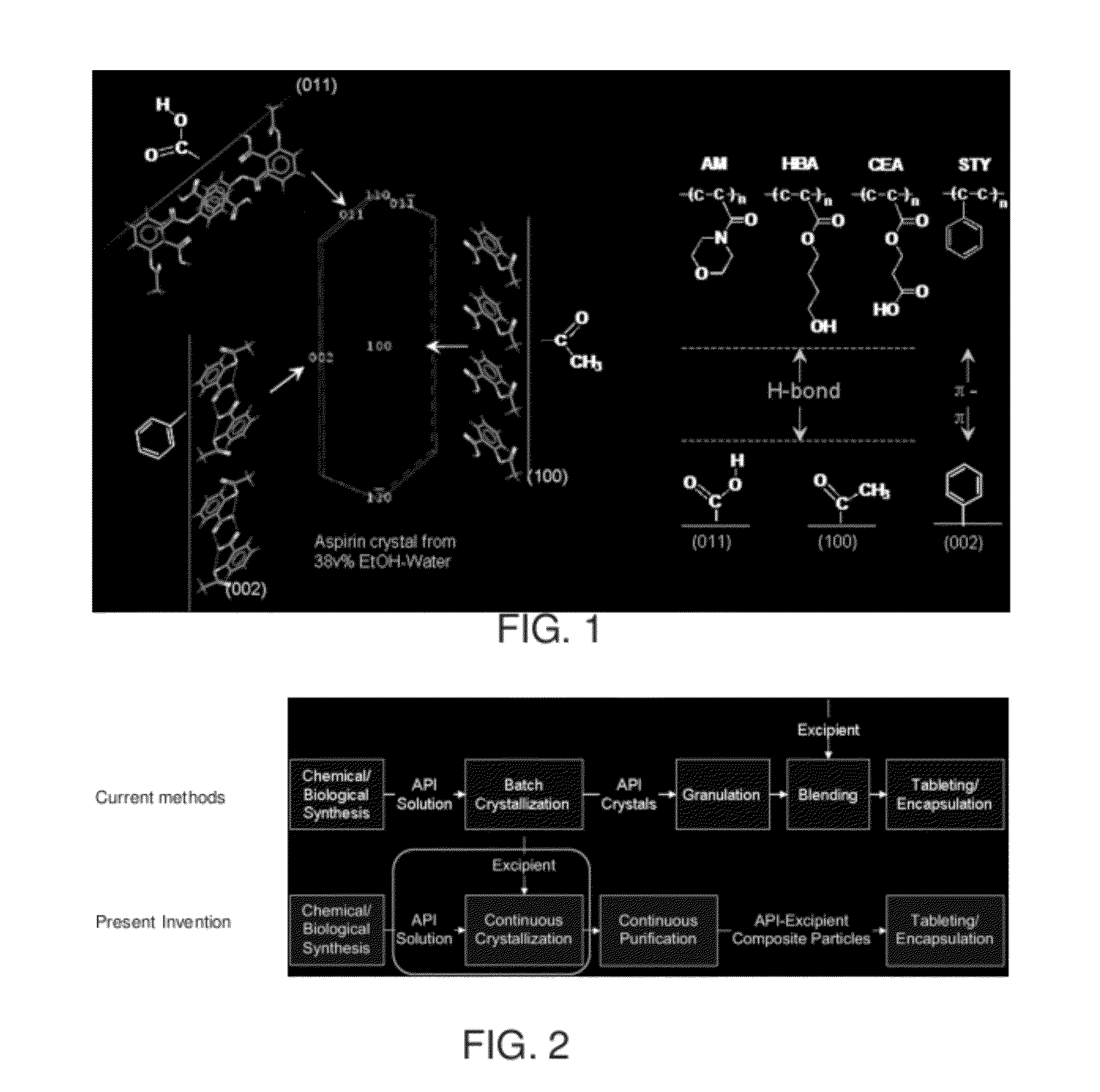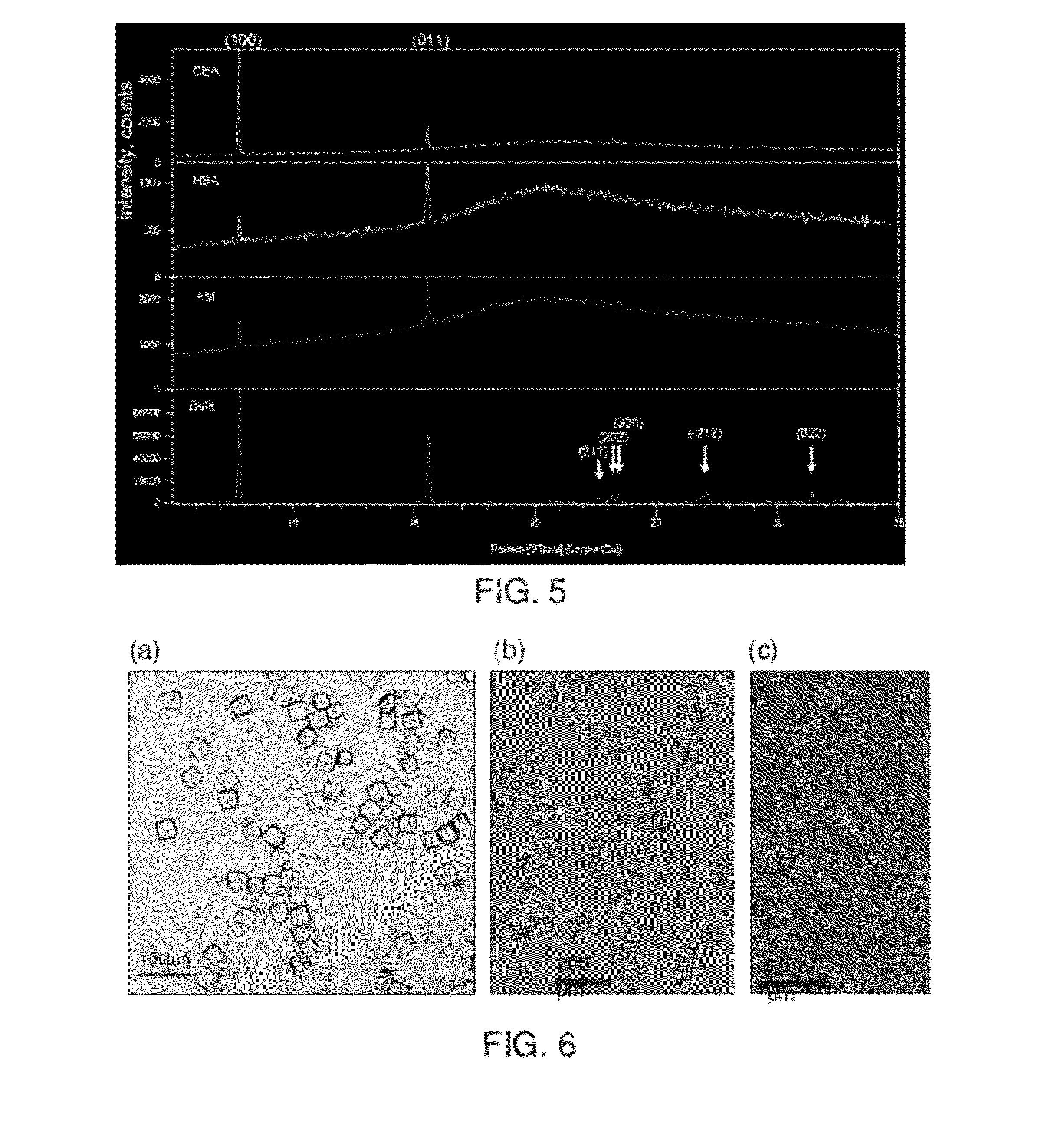Compositions, methods, and systems relating to controlled crystallization and/or nucleation of molecular species
a technology of controlled crystallization and molecular species, applied in the direction of crystallization separation, crystal growth process, separation process, etc., can solve the problems of large application restrictions of these approaches, complexity partially arises, and insufficient mechanistic understanding to enable rational design of surface chemistry. , to achieve the effect of greater affinity
- Summary
- Abstract
- Description
- Claims
- Application Information
AI Technical Summary
Benefits of technology
Problems solved by technology
Method used
Image
Examples
example 1
[0114]The following example provides both prophetic and working examples of methods and systems of the present invention. In this Example, exemplary methods and systems for controlling the nucleation of small organic compounds from solution by tuning the surface chemistry and morphology of amorphous substrates are described. Polymers are synthesized with various surface chemistries and pore structures to expedite the nucleation of small organic molecules.
[0115]In many areas of science and technology, such as the production of pharmaceuticals, semiconductors, and optics, as well as the formation of biominerals, the ability to control crystallization is desired. Nucleation is an important step in controlling the crystallization process. Generally, crystallization starts with heterogeneous nucleation which occurs at random foreign surfaces.
[0116]Controlling nucleation kinetics and nucleation density by adjusting surface chemistry: Nucleation is an activated process. The presence of int...
example 2
[0137]The following example provides both prophetic and working examples of methods and systems of the present invention. This example describes exemplary methods and systems for the nanostructure and chemical makeup of polymer particles to control nucleation from solution. The methods and system may allow for the synthesis of unique composite particles comprised of crystalline active pharmaceutical ingredient and polymeric excipients.
[0138]As described above, in many areas of science and technology, such as the production of pharmaceuticals, semiconductors and optics, as well as the formation of biominerals, the ability to control crystallization is desired
[0139]Synthesis of porous polymer particles with controlled porous microstructure: The polymer particles involved in this example are hydrogels. Hydrogels will be known to those of ordinary kill in the art and are generally defined by a chemically cross-linked network which swells in the presence of solvent such that the total vo...
example 3
[0175]It is well recognized that surfaces may play an important role in liquid-solid phase transformations, and surface morphology has been shown to impact nucleation and crystallization. However, current fundamental understanding is insufficient to allow the rational design of surfaces for nucleation / crystallization control. It is generally accepted that surface roughness helps promote nucleation, although little is known of the role that cavity shape of the rough surface plays in the nucleation process. This example shows that the shape of surface nanopores (e.g., which are described in the specification as features or wells) can affect the nucleation behavior. Contrary to common belief, a rough surface may inhibit nucleation of a molecular crystal from solution depending on surface morphology. The role played by surface chemistry in nanopore-induced nucleation, in some embodiments, is demonstrated in this example. Direction regarding surface-induced crystallization is provided, w...
PUM
| Property | Measurement | Unit |
|---|---|---|
| average size | aaaaa | aaaaa |
| average size | aaaaa | aaaaa |
| average size | aaaaa | aaaaa |
Abstract
Description
Claims
Application Information
 Login to View More
Login to View More - R&D
- Intellectual Property
- Life Sciences
- Materials
- Tech Scout
- Unparalleled Data Quality
- Higher Quality Content
- 60% Fewer Hallucinations
Browse by: Latest US Patents, China's latest patents, Technical Efficacy Thesaurus, Application Domain, Technology Topic, Popular Technical Reports.
© 2025 PatSnap. All rights reserved.Legal|Privacy policy|Modern Slavery Act Transparency Statement|Sitemap|About US| Contact US: help@patsnap.com



